Enhancing Electric Discharge Machining Performance by Selecting Electrode Design and Geometrical Parameters for Square, Triangular, and Hexagonal Profiled Holes
Abstract
:1. Introduction
2. Materials and Methods
3. Results and Discussion
3.1. Parametric Effects on Material Removal Rate
3.2. Parametric Effects on Tool Wear Rate
3.3. Parametric Effects on Surface Roughness
3.4. Composite Desirability Based Multi-Response Optimization
4. Conclusions
- The circular relief angled tool designs (CRL) offer better MRR than the traditional tools for machining or cutting square, triangular, and hexagonal non-circular hole profiles.
- Among those three non-circular hole profiles (i.e., square, triangular, and hexagonal profiles), the highest MRR (317.24 × 106 μm3/s) is resulted while machining hexagonal holes.
- While machining hexagonal and triangular holes, more tool erosion occurred compared to machining square holes. In the case of square holes, there is evidence of the lowest TWR of 3.87 × 106 m3/s, which is 62.93% and 122.99% less than the reported TWR rate for the triangular and hexagonal tools, respectively. The lowest surface roughness Ra = 7.8 μm has been obtained when a square Cu electrode is used with a 4 mm land and 4 mm workpiece thickness. The magnitude of surface roughness is 62.43%, and 66.66% better than the obtained surface roughness by a triangular Cu electrode with a land thickness 3 mm, and conventional hexagonal Cu electrode with no land thickness, respectively.
- Taking into consideration the desired outcomes of achieving a high material removal rate, low tool wear rate, and surface roughness simultaneously, the optimal tool design parameters are determined for three distinct types of non-circular through-holes (specifically square, triangular, and hexagonal) in D2 steel. These parameters have been identified through a comprehensive composite desirability analysis, ensuring an ideal combination of performance factors.
- ▪
- For the square cross-sectional through-holes, the optimal tool design parameters recommended are: tool design = circular relief angled design (CRL), relief angle = 20 deg, land thickness = 2 mm, and workpiece thickness = 4 mm.
- ▪
- Similarly, for the triangular through-holes, the most suitable tool design parameters recommended are: tool design = circular relief angled design (CRL), relief angle = 20 deg, land thickness = 4 mm, and workpiece thickness = 8 mm.
- ▪
- Lastly, for the hexagonal through-holes, the recommended tool design parameters are: tool design = circular relief angled design (CRL), relief angle = 40 deg, land thickness = 2 mm, and workpiece thickness = 8 mm.
Author Contributions
Funding
Data Availability Statement
Acknowledgments
Conflicts of Interest
References
- Davis, J.R. ASM Specialty Handbook: Tool Materials; ASM International: Almere, The Netherlands, 1995; ISBN 978-0-87170-545-7. [Google Scholar]
- Hickey, K. Tooling and Die Wear. Available online: https://ahssinsights.org/forming/tooling/tooling-and-die-wear/ (accessed on 7 August 2023).
- Campi, F.; Favi, C.; Mandolini, M.; Germani, M. Using Design Geometrical Features to Develop an Analytical Cost Estimation Method for Axisymmetric Components in Open-Die Forging. Procedia CIRP 2019, 84, 656–661. [Google Scholar] [CrossRef]
- Tsai, K.-M.; Wang, P.-J. Semi-Empirical Model of Surface Finish on Electrical Discharge Machining. Int. J. Mach. Tools Manuf. 2001, 41, 1455–1477. [Google Scholar] [CrossRef]
- Qudeiri, J.E.A.; Zaiout, A.; Mourad, A.-H.I.; Abidi, M.H.; Elkaseer, A. Principles and Characteristics of Different EDM Processes in Machining Tool and Die Steels. Appl. Sci. 2020, 10, 2082. [Google Scholar] [CrossRef]
- Valaki, J.B.; Rathod, P.P. Assessment of Operational Feasibility of Waste Vegetable Oil Based Bio-Dielectric Fluid for Sustainable Electric Discharge Machining (EDM). Int. J. Adv. Manuf. Technol. 2016, 87, 1509–1518. [Google Scholar] [CrossRef]
- Bhatia, K.; Singla, A.; Sharma, A.; Sengar, S.S.; Selokar, A. A Review on Different Dielectric Fluids and Machining of Si3N4 and Al2O3 Composites via EDM. In Advances in Industrial and Production Engineering; Shanker, K., Shankar, R., Sindhwani, R., Eds.; Lecture Notes in Mechanical Engineering; Springer: Singapore, 2019; pp. 585–596. ISBN 9789811364112. [Google Scholar]
- Wang, C.; Qiang, Z. Comparison of Micro-EDM Characteristics of Inconel 706 between EDM Oil and an Al Powder-Mixed Dielectric. Adv. Mater. Sci. Eng. 2019, 2019, 5625360. [Google Scholar] [CrossRef]
- Hourmand, M.; Sarhan, A.A.D.; Farahany, S.; Sayuti, M. Microstructure Characterization and Maximization of the Material Removal Rate in Nano-Powder Mixed EDM of Al-Mg2Si Metal Matrix Composite—ANFIS and RSM Approaches. Int. J. Adv. Manuf. Technol. 2019, 101, 2723–2737. [Google Scholar] [CrossRef]
- Batish, A.; Bhattacharya, A.; Kumar, N. Powder Mixed Dielectric: An Approach for Improved Process Performance in EDM. Part. Sci. Technol. 2015, 33, 150–158. [Google Scholar] [CrossRef]
- Bahgat, M.M.; Shash, A.Y.; Abd-Rabou, M.; El-Mahallawi, I.S. Influence of Process Parameters in Electrical Discharge Machining on H13 Die Steel. Heliyon 2019, 5, e01813. [Google Scholar] [CrossRef]
- Klocke, F.; Schwade, M.; Klink, A.; Veselovac, D. Analysis of Material Removal Rate and Electrode Wear in Sinking EDM Roughing Strategies Using Different Graphite Grades. Procedia CIRP 2013, 6, 163–167. [Google Scholar] [CrossRef]
- Younis, M.A.; Abbas, M.S.; Gouda, M.A.; Mahmoud, F.H.; Abd Allah, S.A. Effect of Electrode Material on Electrical Discharge Machining of Tool Steel Surface. Ain Shams Eng. J. 2015, 6, 977–986. [Google Scholar] [CrossRef]
- Sahu, J.; Shrivastava, S.; Mohanty, C.; Mishra, S.; Mahanta, T.K. Effect of Polarity on MRR and TWR in Electric Discharge Machining. In Advances in Mechanical Processing and Design; Pant, P., Mishra, S.K., Mishra, P.C., Eds.; Lecture Notes in Mechanical Engineering; Springer: Singapore, 2021; pp. 543–550. ISBN 9789811577789. [Google Scholar]
- Kumar, S.; Sharma, V. Current Scenario in Optimization of Machining Parameters While Electric Discharge Machining for Biocompatible Ti-Alloy: A Review. In Advances in Engineering Materials; Sharma, B.P., Rao, G.S., Gupta, S., Gupta, P., Prasad, A., Eds.; Lecture Notes in Mechanical Engineering; Springer: Singapore, 2021; pp. 473–480. ISBN 978-981-336-028-0. [Google Scholar]
- Abed, F.N.; Ramesh, V.; Fadhil Jwaid, M.; Agarwal, N.; Koundal, D.; Mohamed Ibrahim, A. Enhancement Modelling Based on Electrical Discharge Machining Successive Discharges. Adv. Mater. Sci. Eng. 2022, 2022, 8017375. [Google Scholar] [CrossRef]
- Kitada, R.; Wang, Q.; Tsuetani, S.; Okada, A. Influence of Surface Roughness of Die Sinking EDM on Mold Releasability in Compression Molding of Thermosetting Phenol Resin. Procedia CIRP 2022, 113, 238–243. [Google Scholar] [CrossRef]
- Dwaraka, R.; Arunachalam, N. Investigation on Non-Invasive Process Monitoring of Die Sinking EDM Using Acoustic Emission Signals. Procedia Manuf. 2018, 26, 1471–1482. [Google Scholar] [CrossRef]
- Sharma, S.; Kumar Vates, U.; Bansal, A. Influence of Die-Sinking EDM Parameters on Machining Characteristics of Alloy 625 and Alloy 718: A Comparative Analysis. Mater. Today Proc. 2022, 50, 2493–2499. [Google Scholar] [CrossRef]
- Shyn, C.S.; Rajesh, R.; Dev Anand, M. Modeling and Prediction of Die Sinking EDM Process Parameters for A6061/6%B4C Metal Matrix Composite Material. Mater. Today Proc. 2021, 42, 677–685. [Google Scholar] [CrossRef]
- Phang, Y.M.; Asmelash, M.; Hamedon, Z.; Azhari, A. Investigation on Turning Operation Using Die Sinking EDM Process. Mater. Today Proc. 2021, 46, 1569–1573. [Google Scholar] [CrossRef]
- Chou, S.-H.; Wang, A.-C. Investigating and Removing the Re-Sticky Debris on Tungsten Carbide in Electrical Discharge Machining. Int. J. Adv. Manuf. Technol. 2014, 71, 1151–1158. [Google Scholar] [CrossRef]
- Yadav, V.K.; Kumar, P.; Dvivedi, A. Performance Enhancement of Rotary Tool Near-Dry EDM of HSS by Supplying Oxygen Gas in the Dielectric Medium. Mater. Manuf. Process. 2019, 34, 1832–1846. [Google Scholar] [CrossRef]
- Cui, J.; Chu, Z. Composite Motion Design Procedure for Vibration Assisted Small-Hole EDM Using One Voice Coil Motor. Shock Vib. 2016, 2016, 4179296. [Google Scholar] [CrossRef]
- Khajuria, A.; Bedi, R.; Singh, B.; Akhtar, M. EDM Machinability and Parametric Optimisation of 2014Al/Al2O3 Composite by RSM. Int. J. Mach. Mach. Mater. 2018, 20, 536–555. [Google Scholar] [CrossRef]
- Manikandan, N.; Raju, R.; Palanisamy, D.; Binoj, J.S. Optimisation of Spark Erosion Machining Process Parameters Using Hybrid Grey Relational Analysis and Artificial Neural Network Model. Int. J. Mach. Mach. Mater. 2019, 22, 1–23. [Google Scholar] [CrossRef]
- Kumar, P.; Parkash, R. Experimental Investigation and Optimization of EDM Process Parameters for Machining of Aluminum Boron Carbide (Al–B4C) Composite. Mach. Sci. Technol. 2016, 20, 330–348. [Google Scholar] [CrossRef]
- Singh, J.; Sharma, R.K. Multi-Objective Optimization of Green Powder-Mixed Electrical Discharge Machining of Tungsten Carbide Alloy. Proc. Inst. Mech. Eng. Part C J. Mech. Eng. Sci. 2018, 232, 2774–2786. [Google Scholar] [CrossRef]
- Rajamanickam, S.; Prasanna, J. Multi Objective Optimization during Small Hole Electrical Discharge Machining (EDM) of Ti-6Al-4V Using TOPSIS. Mater. Today Proc. 2019, 18, 3109–3115. [Google Scholar] [CrossRef]
- Ahmad Mufti, N.; Rafaqat, M.; Ahmed, N.; Qaiser Saleem, M.; Hussain, A.; Al-Ahamri, A.M. Improving the Performance of EDM through Relief-Angled Tool Designs. Appl. Sci. 2020, 10, 2432. [Google Scholar] [CrossRef]
- Stamping Die Material Types And Characteristics_Low-Alloy Tool, High Speed Steel, Base Steel, Traditional Mold Steel, Cr12 and Cr12MoV. Available online: https://metalpartss.com/Stamping_Die_Material_Types_And_Characteristics/ (accessed on 7 August 2023).
- Mahajan, R.; Krishna, H.; Singh, A.K.; Ghadai, R.K. A Review on Copper and Its Alloys Used as Electrode in EDM. IOP Conf. Ser. Mater. Sci. Eng. 2018, 377, 012183. [Google Scholar] [CrossRef]
- Sharma, A.; Kumar Sinha, A. Rotary Electric Discharge Machining of AISI D2 Tool Steel: Present and Future Scope. Mater. Today Proc. 2018, 5, 18562–18567. [Google Scholar] [CrossRef]
- Patel, N.J. Review on Effects of Electrode in Electrical Discharge Machining Process. Int. J. Res. Rev. 2021, 8, 91. [Google Scholar] [CrossRef]
- Guu, Y.H. AFM Surface Imaging of AISI D2 Tool Steel Machined by the EDM Process. Appl. Surf. Sci. 2005, 242, 245–250. [Google Scholar] [CrossRef]
- Tool Steels, 5th Edition—George Adam Roberts, Richard Kennedy, G. Krauss—Google Books. Available online: https://books.google.com.pk/books?id=ScphevR_eP8C&printsec=copyright&redir_esc=y#v=onepage&q&f=false (accessed on 3 February 2020).
- D2 Tool Steel—High-Carbon, High-Chromium, Cold-Work Steel (UNS T30402). Available online: https://www.azom.com/article.aspx?ArticleID=6214 (accessed on 27 January 2020).
- Rafaqat, M.; Mufti, N.A.; Saleem, M.Q.; Ahmed, N.; Rehman, A.U.; Ali, M.A. Machining of Triangular Holes in D2 Steel by the Use of Non-Conventional Electrodes in Die-Sinking Electric Discharge Machining. Materials 2023, 16, 3865. [Google Scholar] [CrossRef]
- Yarar, E.; Karabay, S. Investigation of the Effects of Ultrasonic Assisted Drilling on Tool Wear and Optimization of Drilling Parameters. CIRP J. Manuf. Sci. Technol. 2020, 31, 265–280. [Google Scholar] [CrossRef]
- Yarar, E.; Koç, F.G.; Angigün, F.; Demirci, Ş.; Makas, T. Multi-Response Optimization and Machinability Research of Forging and Heat Treatment Parameters in Piston Production. Multiscale Multidiscip. Model. Exp. Des. 2023, 6, 305–317. [Google Scholar] [CrossRef]
- Rafaqat, M.; Mufti, N.A.; Saleem, M.Q.; Ahmed, N.; Hussain, A. Electric Discharge Machining of Non-Circular through-Holes: Material Removal and Tool Wear Analysis. J. Braz. Soc. Mech. Sci. Eng. 2023, 45, 135. [Google Scholar] [CrossRef]

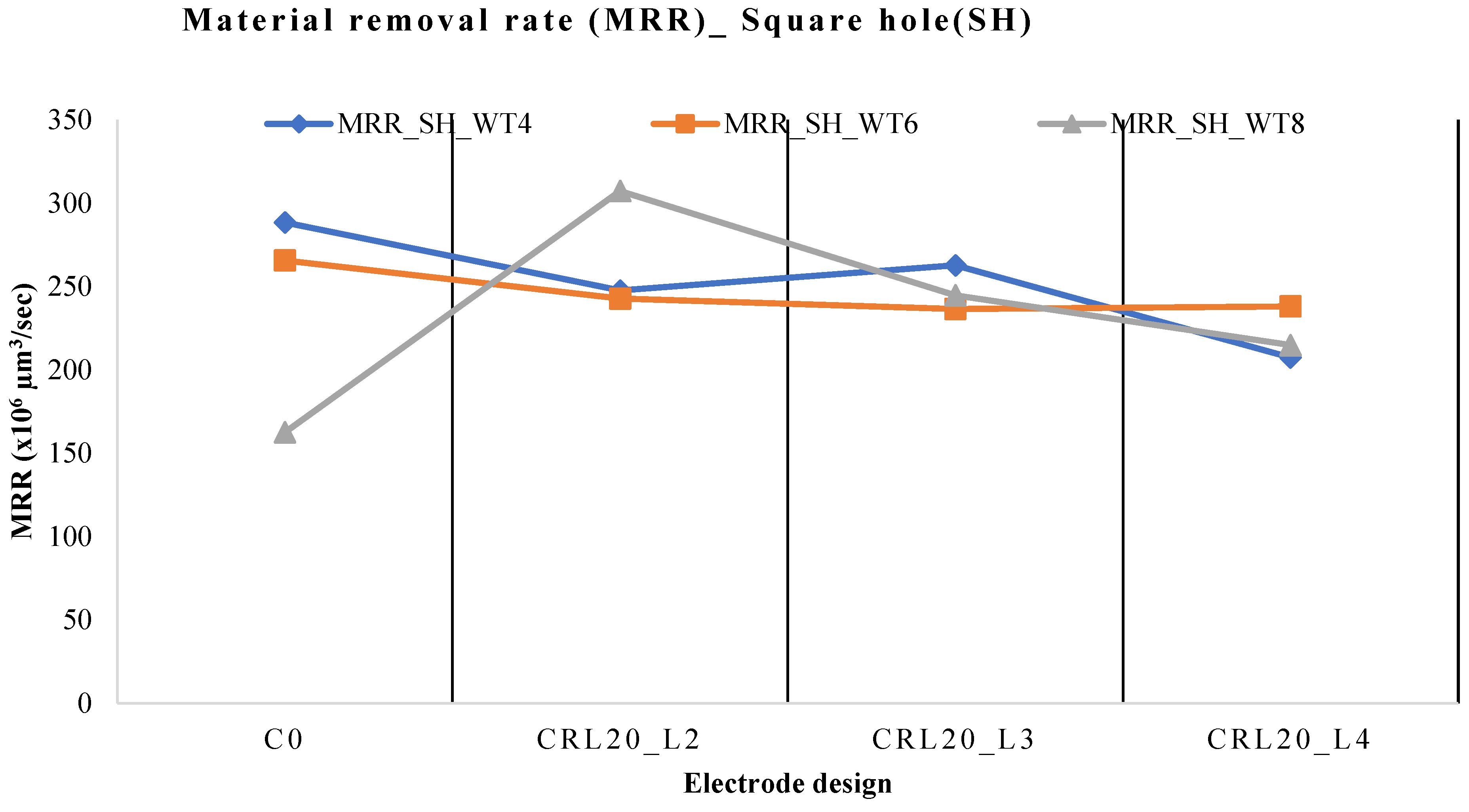






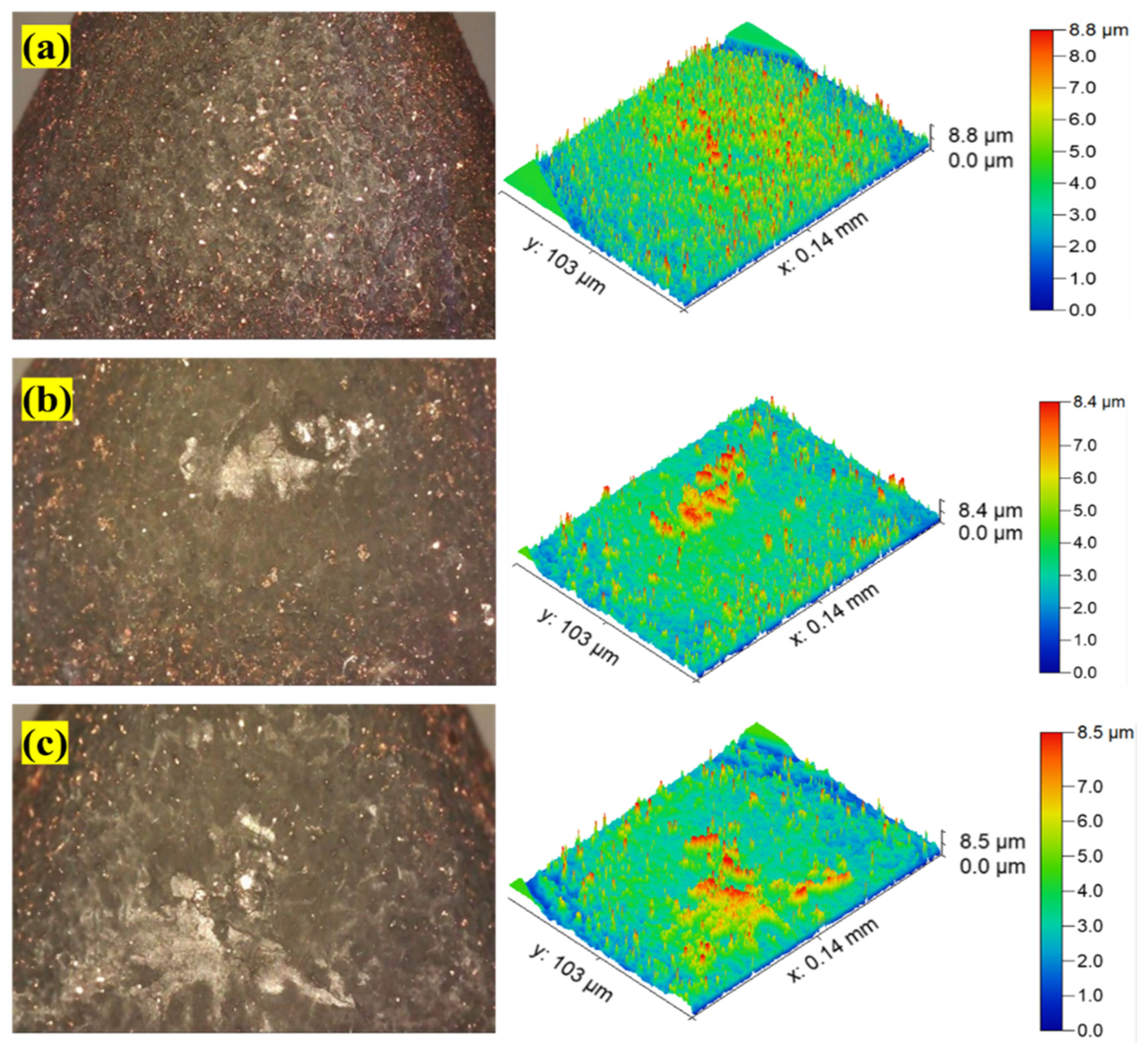
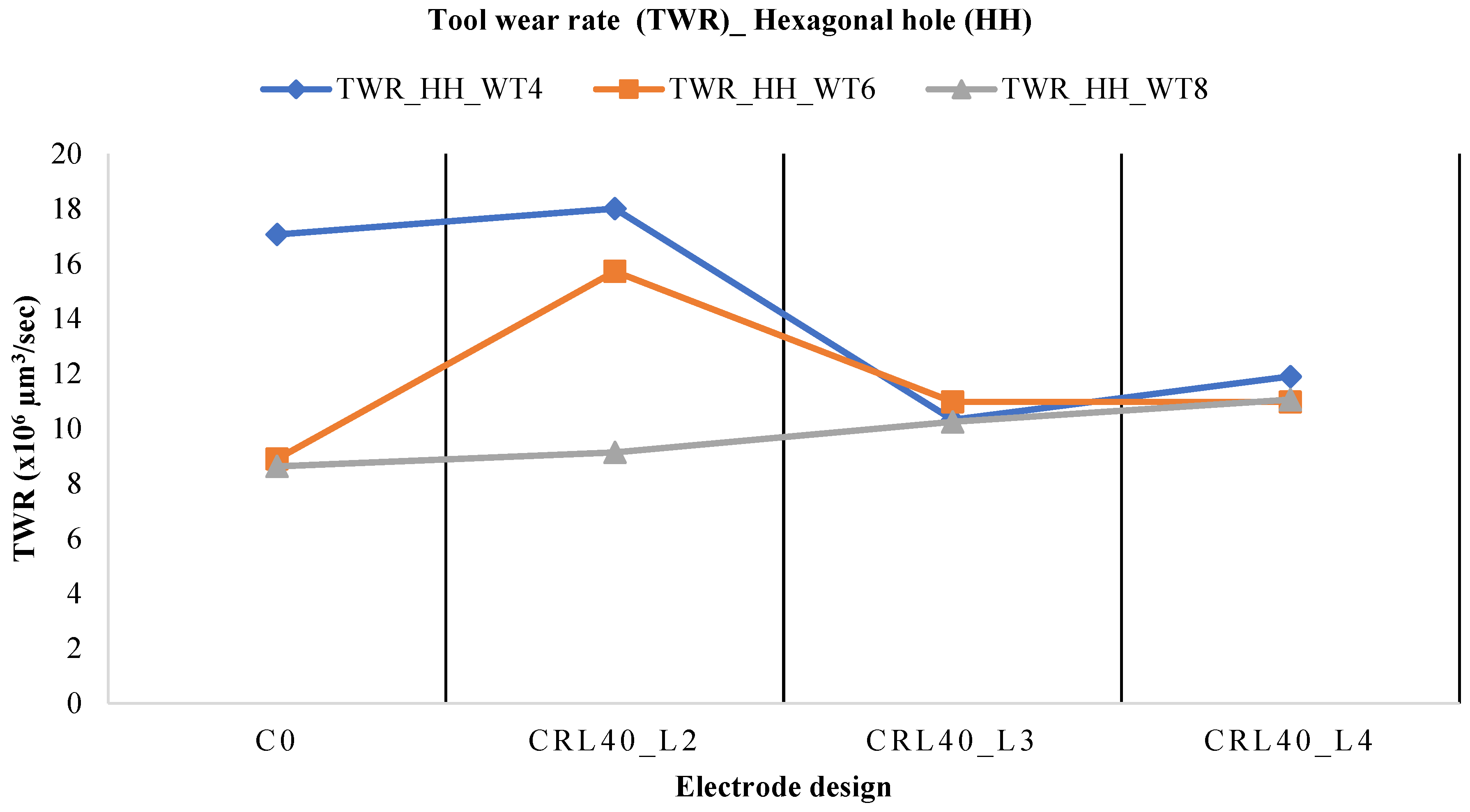
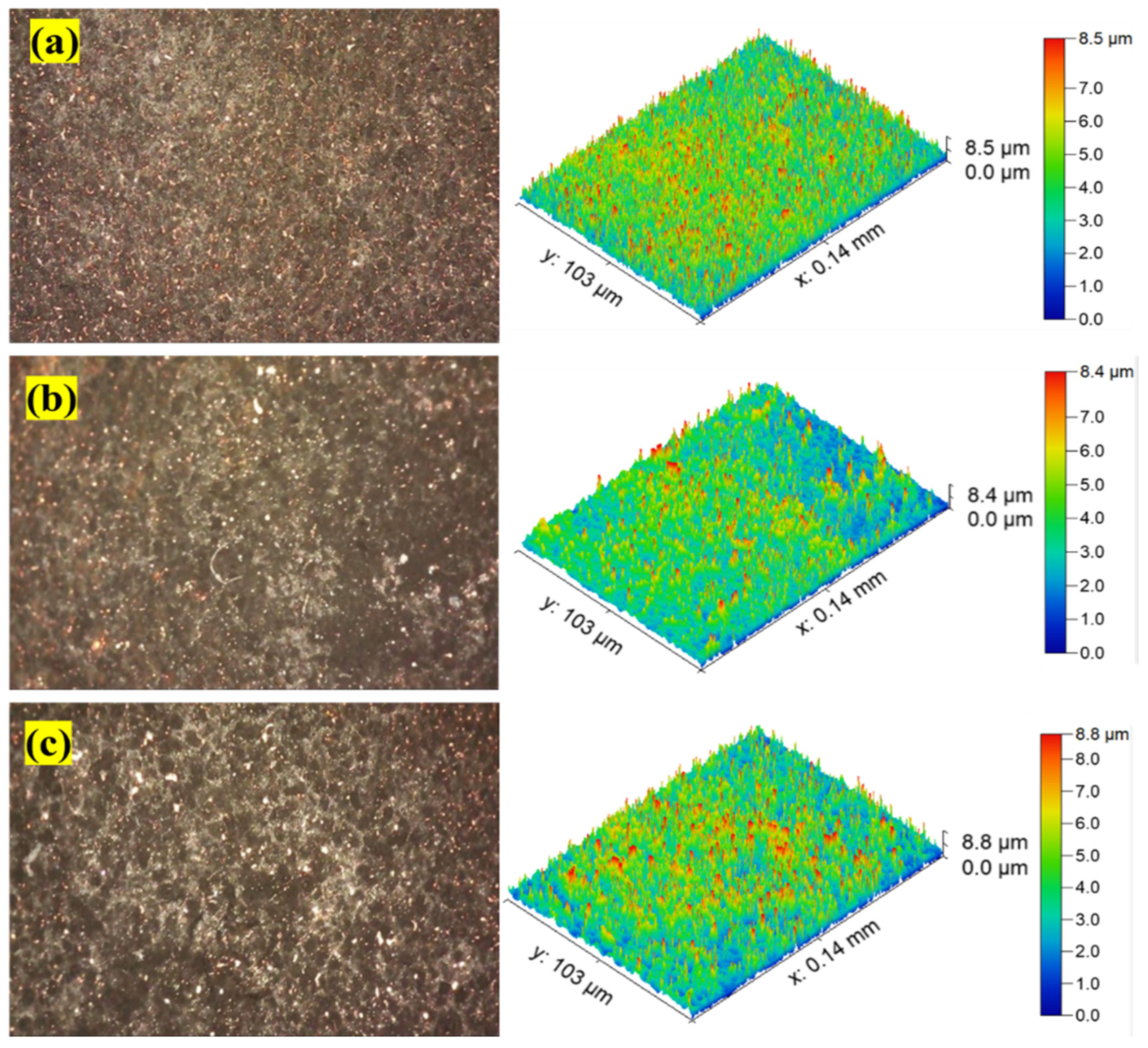
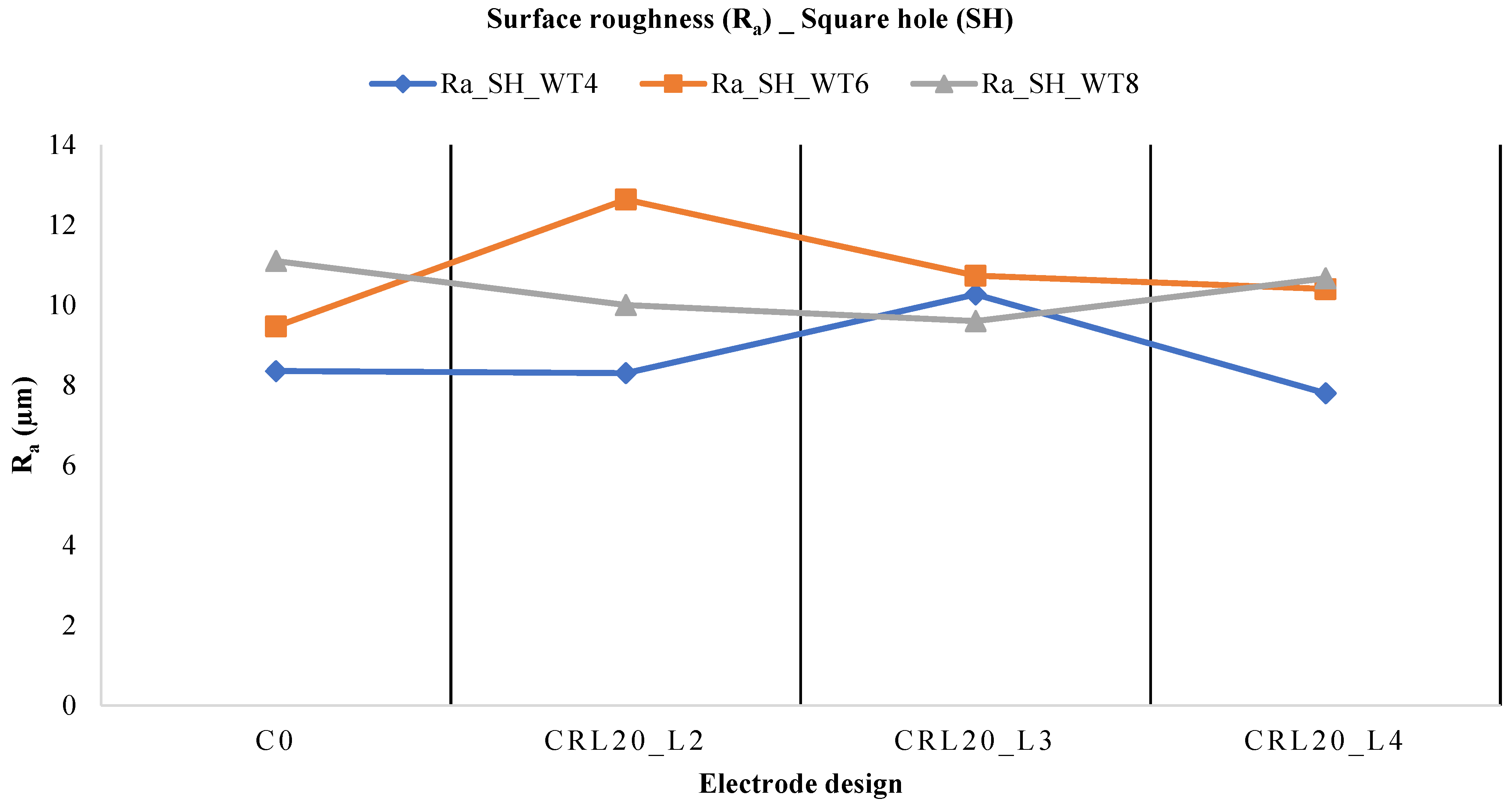

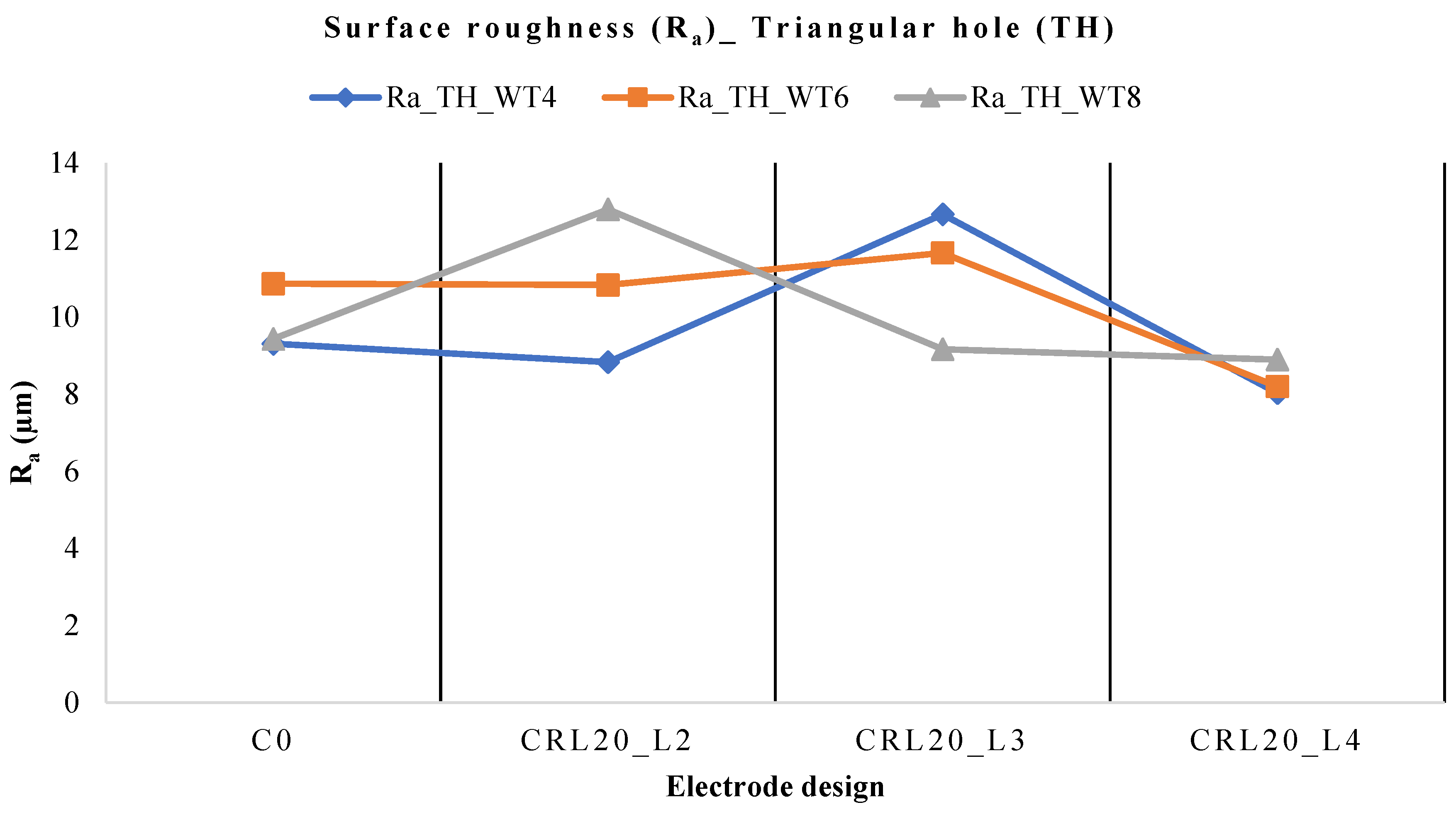

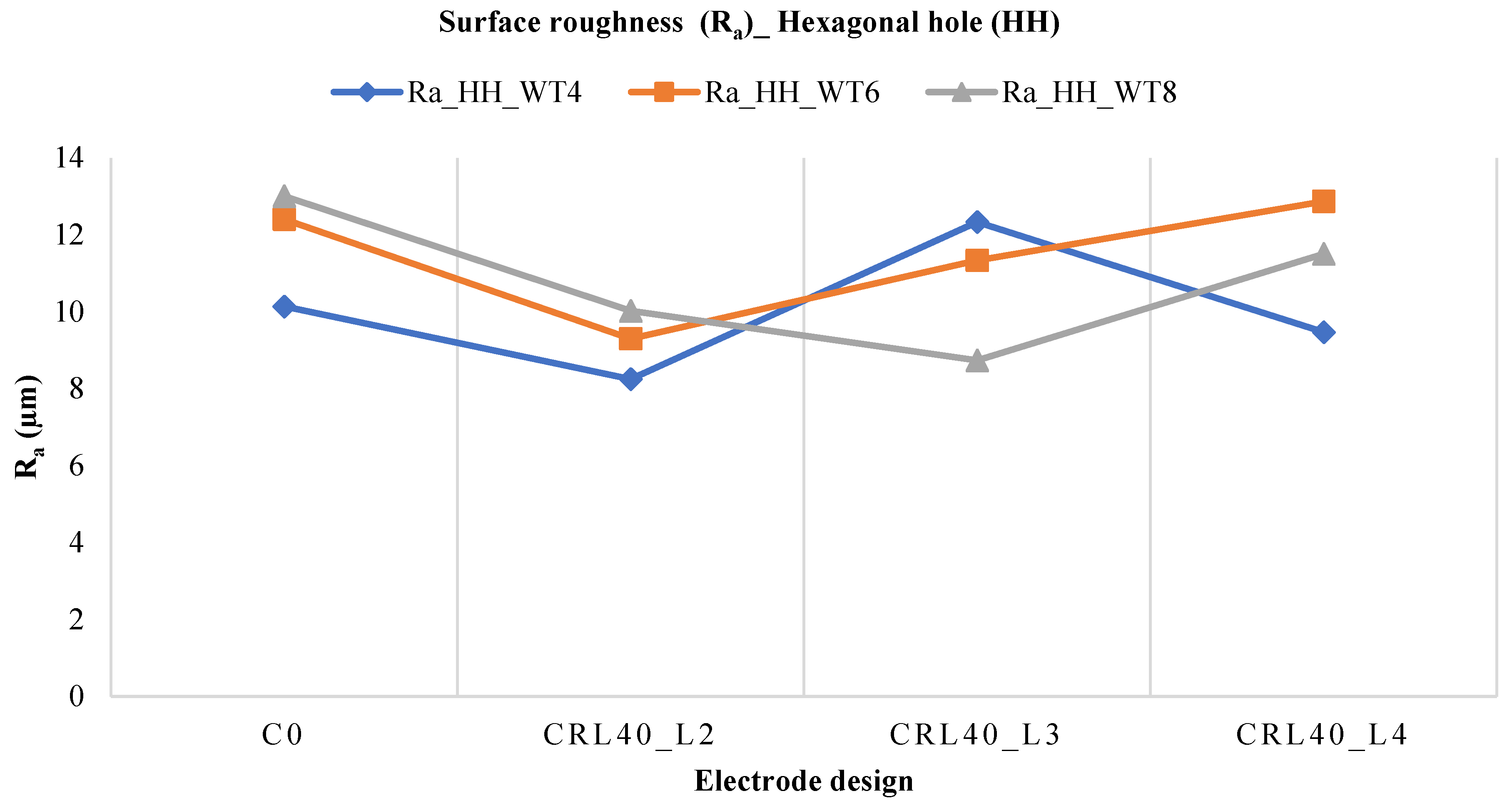


| Elemental Composition (Content %) | Physical Properties | Mechanical Properties | |||
|---|---|---|---|---|---|
| C | 1.5 | Properties | Value (Units) | Properties | Value (Units) |
| Si | 0.3 | Density | 7.7 × 1000 kg/m3 | Hardness | 55–62 HRC |
| Mo | 1 | Melting point | 1421 °C | Hardness | 748 HV |
| Cr | 12 | Poisson’s ratio | 0.27–0.30 | ||
| Ni | 0.3 | Elastic modulus | 210 GPa | ||
| V | 0.8 | ||||
| Co | 1 | ||||
| Fe | Balance | ||||
| Design Parameters | Levels | ||
|---|---|---|---|
| 1 | 2 | 3 | |
| Electrode design | Conventional (C0) | Circular relief (CRL) | - |
| Relief angle (deg) | 0 | 20 | 40 |
| Hole shape | Square | Triangular | Hexagonal |
| Land height (mm) | 2 | 3 | 4 |
| Work thickness (mm) | 4 | 6 | 8 |
| Tool Parameters | EDM Parameters | ||
|---|---|---|---|
| Tool material | Copper | Discharge current | 20 A |
| Tool height | 50 mm | Spark voltage | 5 V |
| Shank cross-section | Circular | Pulse on-time | 100 μs |
| Shank diameter | 6 mm | Pulse off-time | 50 μs |
| Face length | 12 mm | Spark time | 5 s |
| Face cross-section | Square | Flush time | 5 s |
| Triangular | |||
| Hexagonal | |||
| Parameters | Response Measures | ||||||||||
|---|---|---|---|---|---|---|---|---|---|---|---|
| Square Holes | Triangular Holes | Hexagonal Holes | |||||||||
| Tool design | Land thickness; LT (mm) | Workpiece thickness; WT (mm) | MRR_SH (×106 μm3/s) | TWR_SH (×106 μm3/s) | Ra_SH (μm) | MRR_TH (×106 μm3/s) | TWR_TH (×106 μm3/s) | Ra_TH (μm) | MRR_HH (×106 μm3/s) | TWR_HH (×106 μm3/s) | Ra_HH (μm) |
| C0 | 0 | 4 | 288.38 | 26.10 | 8.35 | 221.70 | 48.77 | 9.31 | 286.24 | 17.07 | 10.13 |
| 0 | 6 | 265.62 | 21.99 | 9.47 | 134.30 | 31.62 | 10.87 | 248.76 | 8.90 | 12.40 | |
| 0 | 8 | 162.51 | 10.84 | 11.10 | 140.57 | 27.90 | 9.43 | 223.99 | 8.63 | 13.00 | |
| CRLL2 | 2 | 4 | 247.53 | 15.63 | 8.30 | 251.61 | 48.82 | 8.83 | 317.24 | 18.02 | 8.25 |
| 2 | 6 | 242.69 | 3.87 | 12.63 | 207.48 | 40.21 | 10.83 | 223.52 | 15.73 | 9.30 | |
| 2 | 8 | 307.21 | 15.76 | 10.00 | 212.36 | 38.36 | 12.80 | 192.45 | 9.14 | 10.02 | |
| CRLL3 | 3 | 4 | 262.62 | 13.96 | 10.27 | 164.13 | 38.62 | 12.67 | 260.29 | 10.33 | 12.33 |
| 3 | 6 | 236.49 | 16.55 | 10.73 | 177.24 | 35.59 | 11.67 | 137.06 | 10.98 | 11.33 | |
| 3 | 8 | 244.66 | 13.64 | 9.60 | 185.22 | 34.30 | 9.17 | 188.89 | 10.25 | 8.73 | |
| CRLL4 | 4 | 4 | 207.36 | 14.27 | 7.80 | 192.81 | 36.22 | 8.03 | 274.00 | 11.90 | 9.47 |
| 4 | 6 | 238.02 | 13.24 | 10.40 | 184.72 | 35.59 | 8.20 | 261.50 | 10.97 | 12.87 | |
| 4 | 8 | 214.77 | 12.72 | 10.67 | 202.88 | 33.60 | 8.90 | 243.86 | 11.06 | 11.50 | |
Disclaimer/Publisher’s Note: The statements, opinions and data contained in all publications are solely those of the individual author(s) and contributor(s) and not of MDPI and/or the editor(s). MDPI and/or the editor(s) disclaim responsibility for any injury to people or property resulting from any ideas, methods, instructions or products referred to in the content. |
© 2023 by the authors. Licensee MDPI, Basel, Switzerland. This article is an open access article distributed under the terms and conditions of the Creative Commons Attribution (CC BY) license (https://creativecommons.org/licenses/by/4.0/).
Share and Cite
Rafaqat, M.; Mufti, N.A.; Saleem, M.Q.; Ahmed, N.; Rehman, A.U.; Zahoor, S.; Ali, M.A. Enhancing Electric Discharge Machining Performance by Selecting Electrode Design and Geometrical Parameters for Square, Triangular, and Hexagonal Profiled Holes. Processes 2023, 11, 2661. https://doi.org/10.3390/pr11092661
Rafaqat M, Mufti NA, Saleem MQ, Ahmed N, Rehman AU, Zahoor S, Ali MA. Enhancing Electric Discharge Machining Performance by Selecting Electrode Design and Geometrical Parameters for Square, Triangular, and Hexagonal Profiled Holes. Processes. 2023; 11(9):2661. https://doi.org/10.3390/pr11092661
Chicago/Turabian StyleRafaqat, Madiha, Nadeem Ahmad Mufti, Muhammad Qaiser Saleem, Naveed Ahmed, Ateekh Ur Rehman, Sadaf Zahoor, and Muhammad Asad Ali. 2023. "Enhancing Electric Discharge Machining Performance by Selecting Electrode Design and Geometrical Parameters for Square, Triangular, and Hexagonal Profiled Holes" Processes 11, no. 9: 2661. https://doi.org/10.3390/pr11092661







